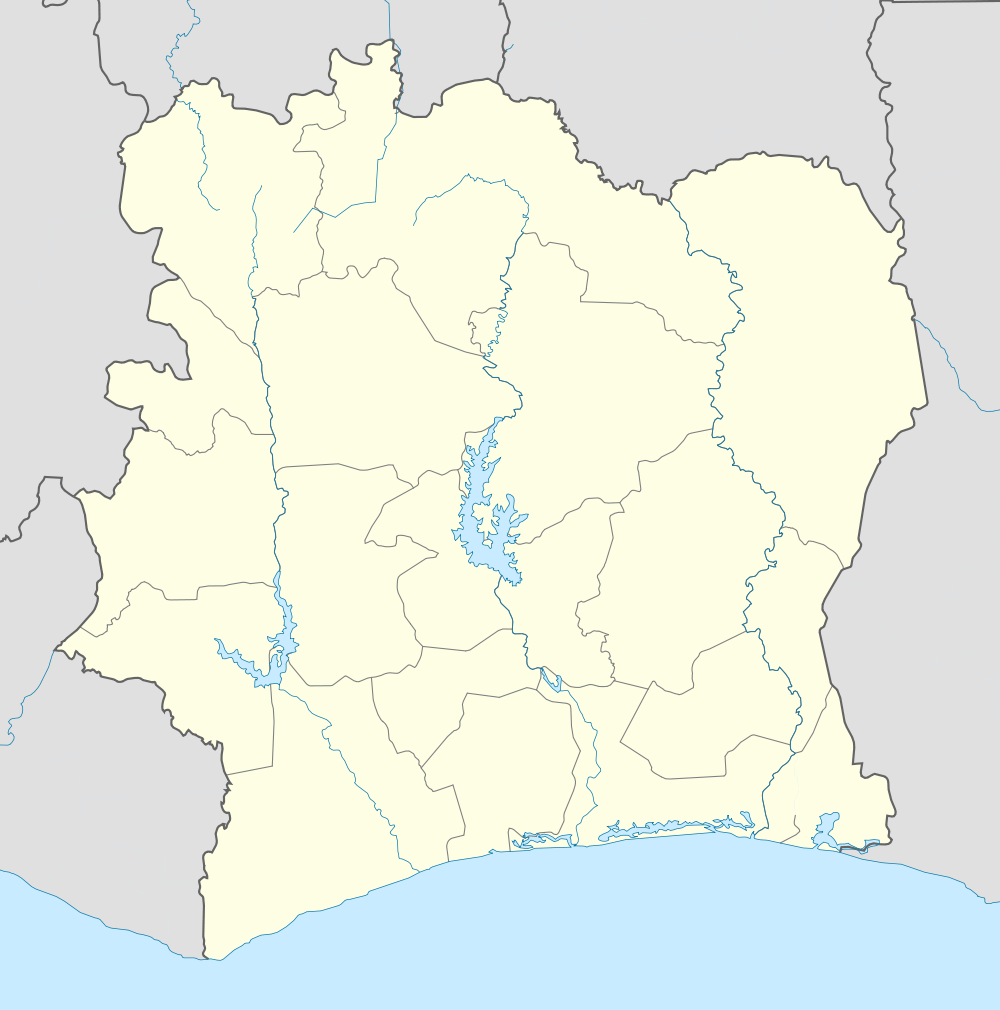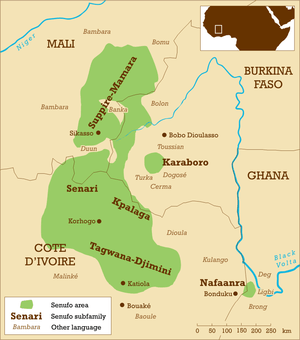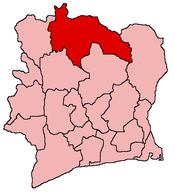Ferkessédougou
| Ferkessédougou | |
|---|---|
| Nickname(s): Ferké | |
 Ferkessédougou Location within Côte d'Ivoire | |
| Coordinates: 9°36′N 5°12′W / 9.600°N 5.200°W | |
| Country |
|
| Region | Savanes Region |
| Department | Ferkessédougou Department |
| Commune | Ferkessédougou Commune |
| Government | |
| • Type | Commune - collectivité territoriale |
| • Mayor | Traoré Vamoutié |
| Elevation | 316 m (1,037 ft) |
| Population (2007) | |
| • Urban | 65,575 |
| Estimate | |
| Time zone | GMT (UTC+0) |
Ferkessédougou (often shortened to Ferké) is the second largest town in northern Côte d'Ivoire. Ferkessédougou is also the administrative seat of the Ferkessédougou Department, one of four Departments in the Savanes Region. The city is served by Ferkessédougou Airport.
Administrative structure
The city of Ferkessédougou is the administrative seat for the Commune (municipality) of Ferkessédougou, the sous-préfecture of Ferkessédougou, and the Department of Ferkessédougou, which contains 6 sous-préfectures and a number of Communes.
A 1978 law created 27 self-governing Communes in Cote 'Ivoire (Communes de plein exercice), Ferkessédougou among them. The Commune is the administrative seat (chef-lieu) of its sous-préfecture and Department.[1]
The Commune, (titled a collectivité territoriale), is administered by a Municipal Council, presided over by a Mayor. Le Department (also a collectivité territoriale) is governed by a General Council (conseil général) presided over by a président. The sous-prefecture ( an administrative subdivision, or a circonscription administrative déconcentrée) carries out limited functions, overseen by an appointed sous-préfet who reports to aPréfet appointed by the National government at Departmental level. Thus each Department contains both an elected government (a collectivité territoriale) and an administrative officer of the central government (a circonscription administrative déconcentrée). The powers of these two entities, and the administrative bodies which they control, are strictly separated under law.
Ferkessédougou Department contains the following sous-préfectures:
- Diawala
- Ferkessédougou
- Kong
- Koumbala
- Niellé
- Ouangolodougou—Ouangolodougou Department
Regional center
The city is an important center of local development as the nearest large town on the north-south road to the main border posts for crossing into Burkina Faso and Mali. A major transport crossroads, it is home to a regional market, schools, and a hospital.
Local economy
The economy of Ferkessédougou Department is overwhelmingly agricultural, with larger scale commercial farming based on huge cotton and sugarcane plantations. The town is a center for the processing of these commodities, in particular for cattle feed, as it is a center for stockyards of herds of Zebu cattle, driven from the north, and bound for markets further south.[2] A burgeoning tourist industry is based upon Ferkessédougou Department's proximity to the large Comoé National Park(to the east) and Mount Nimba Strict Nature Reserve (to the west).
Population and culture

The dominant ethnic group in the area are the Sénoufo (primarily of Nyarafolo and Kpalaga/Palaka dialect speakers). Sociocultural organization is based on the "Poro", an educational system through which every male adolescent graduates to adulthood.
History
The Department is situated in the heartland of the Senufo people who migrated from the north at the time of the Mali Empire. The Senufo followed traditional African faiths, while many of the Mandinka people were becoming fervent Muslims. The Senufo were soon followed by the Dioula or Jula, a Mandinka merchant class prominent throughout West Africa. The Dioula, as they are called in Côte d'Ivoire, reached the area and settled the nearby city of Kong in the 12th century. Despite being outnumbered by the Senufo, they prospered as traders and advisors in much of the region. In the 18th century, the Kong Empire to the east became a major regional power, and dominated the Ferkessédougou area.
The town of Ferkessédougou was founded as late as the 19th century by Ferkessé, a Niarafola leader pushed to the west by the expansion of the Kong Empire.[3] The name is a contraction of Ferkessés - dougou ("Village" in Bambara).
At the end of the 19th century, the area fell under the control of first Samory Touré's Wassoulou Empire and the French colonial empire. Placed under the Côte d'Ivoire Colony of French West Africa in 1895, the completed section of the planned Abidjan-Niger Railway was constructed north and ended during the colonial period at Ferkessédougou town, lending it increased regional importance. Large scale cotton production was introduced by the French, which remains an important pillar of the local economy today. In the late 1970, Ferkessédougou was designated by the government one of their regional development hubs for industry processing agricultural goods. A 50,000 ton capacity sugar processing plant was built in this period.[3]
Climate
On the southern edge of the Sahel—tropical Savanna belt, Ferkessédougou gets a mean annual rainfall of 1400 mm, making it drier than much of Côte d'Ivoire.[4] It is 1037 ft-316 m in elevation.
| Climate data for Ferkessedougou | |||||||||||||
|---|---|---|---|---|---|---|---|---|---|---|---|---|---|
| Month | Jan | Feb | Mar | Apr | May | Jun | Jul | Aug | Sep | Oct | Nov | Dec | Year |
| Average high °C (°F) | 33 (92) |
34 (94) |
34 (94) |
34 (93) |
33 (92) |
31 (88) |
29 (85) |
28 (83) |
29 (85) |
31 (88) |
33 (91) |
33 (91) |
31.8 (89.7) |
| Average low °C (°F) | 16 (61) |
19 (67) |
23 (74) |
23 (74) |
23 (73) |
22 (71) |
21 (70) |
21 (70) |
21 (69) |
21 (69) |
19 (67) |
17 (63) |
20.5 (69) |
| Average precipitation mm (inches) | 5 (0.2) |
23 (0.9) |
48 (1.9) |
81 (3.2) |
150 (5.9) |
147 (5.8) |
191 (7.5) |
307 (12.1) |
241 (9.5) |
117 (4.6) |
33 (1.3) |
10 (0.4) |
1,353 (53.3) |
| Source: Weatherbase [5] | |||||||||||||
Transport
Ferkessédougou is served by a station on the national railway system.
See also
- Railway stations in Côte d'Ivoire
References
- ↑ Loi n° 78-07 du 9 janvier 1978, portant institution de communes de plein exercice en Côte d'Ivoire, J.O. n° 9 du 23 février 1978, p.348
- ↑ K. Hübl. EXPERIENCES IN THE DEVELOPMENT OF MOLASSES-BASED FEEDING SYSTEMS IN AFRICA, Sugarcane as feed: Proceedings of an FAO Expert Consultation held in Santo Domingo, Dominican Republic, from 7–11 July 1986
- ↑ 3.0 3.1 Mundt (1987), p.68
- ↑ B. Badu-Apraku and A. Menkir. Registration of 16 Extra-Early Maturing Striga Resistant Tropical Maize Inbred Lines. Crop Sci 46:1400-1401 (2006).
- ↑ "Weatherbase: Historical Weather for Ferkessedougou, Cote d'Ivoire". Weatherbase. 2011. Retrieved on November 24, 2011.
- Portions of this article were translated from the French language Wikipedia article fr:Ferkessédougou, 2008-07-03.
- Robert J. Mundt. Historical Dictionary of the Ivory Coast (Côte d'Ivoire). Scarecrow Press/ Metuchen. NJ - London (1987) ISBN 0-8108-2029-3
External links
Coordinates: 09°36′N 05°12′W / 9.600°N 5.200°W
| |||||||||||||||||||||||||
